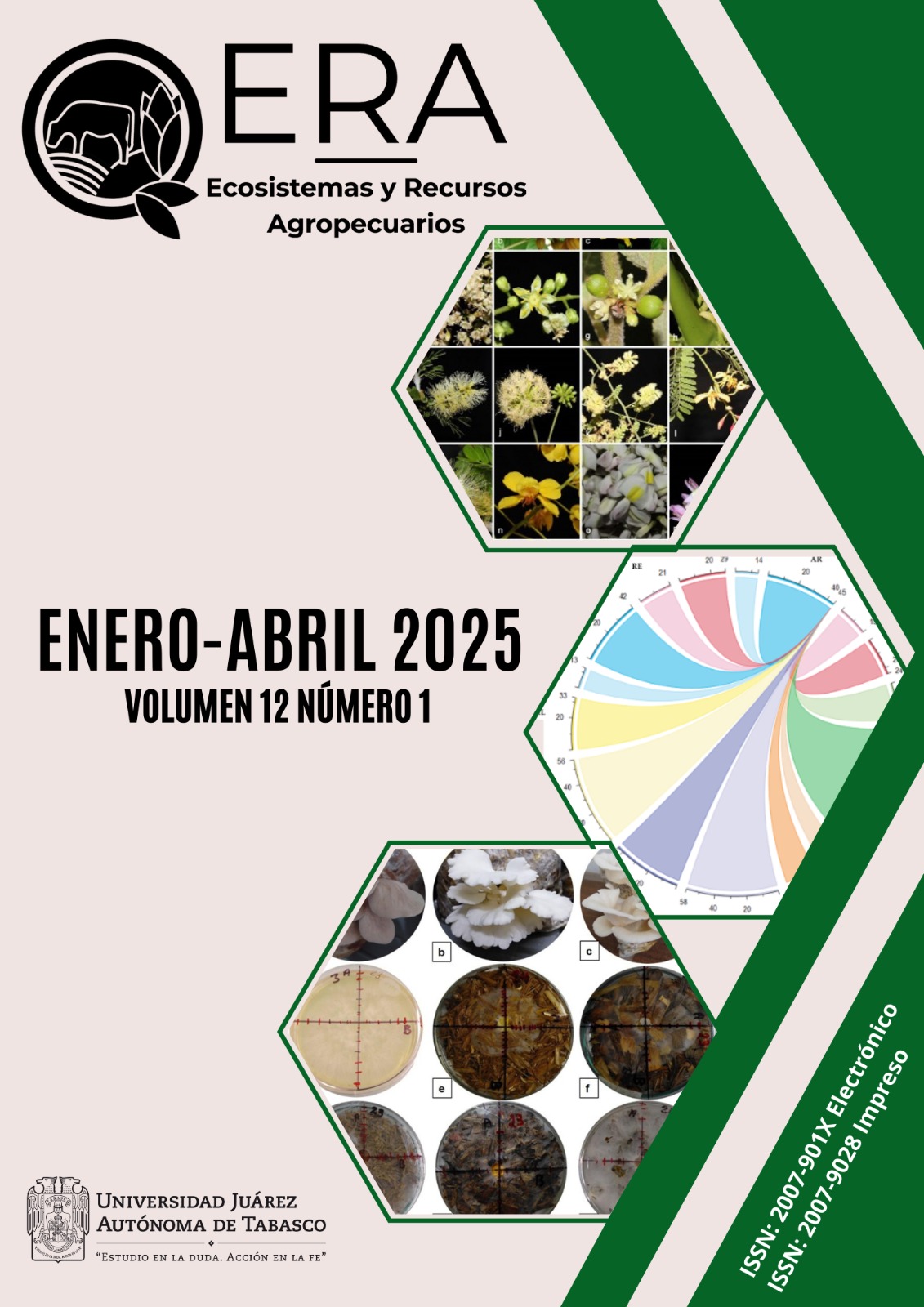Tradescantia spathacea extract as biostimulating in growth and biological activities of Lactobacillus acidophilus and Lacticaseibacillus rhamnosus
DOI:
https://doi.org/10.19136/era.a12n1.4452Keywords:
Biostimulation, phenols, medicinal plant, probioticAbstract
Medicinal plants are an essential source of bioactive compounds with health benefits; however, their impact on probiotic properties remains largely unknown. The aim of this study was to evaluate the biostimulating effect of aqueous extracts of Tradescantia spathacea (EAT) on the development and probiotic properties of Lacticaseibacillus rhamnosus HN001 and Lactobacillus acidophilus La-14. For this purpose, the total phenol content (TPC), total flavonoid content (TFC), and antioxidant activity of EAT were evaluated by spectrophotometric methods (DPPH and ABTS). Subsequently, the biostimulating effect on the growth (BG), antimicrobial activity (AA), cholesterol consumption (CC), and biofilm formation (BFF) of Lacti. rhamnosus and Lacto. acidophilus were evaluated. The EAT presented a TPC of 68.98 ± 5.01 mg GAE g-1 dry extract and TFC of 4.54 ± 0.62 mg CE g-1 dry extract and antioxidant activity with IC50 values of 778.81 ± 60.80 and 4068.16 ± 206.8 µg mL-1, for DPPH and ABTS respectively. The correlation between CFT and antioxidant activity was low (r = -0.7948 and -0.7208; for DPPH and ABTS, respectively). In the BG study, the data showed that EAT stimulated the growth of Lacti. rhamnosus and Lacto. acidophilus and that AA was higher in biostimulated probiotic bacteria. However, CC and FBP were also stimulated by the symbiotic interaction between probiotics and EAT. The aqueous extract of T. spathacea had a biostimulating effect on the probiotic properties of Lacti. rhamnosus HN001 and Lacto. acidophilus La-14.
Downloads
References
Alberto MR, Farías ME, Manca de Nadra, MC (2001) Effect of gallic acid and catechin on Lactobacillus hilgardii 5w growth and metabolism of organic compounds. Journal of Agricultural and Food Chemistry 49(9): 4359-4363. https://doi.org/10.1021/jf0101915
Amarowicz R, Pegg RB (2019) Natural antioxidants of plant origin. In: Ferreira ICFR, Barros L (eds) Functional food ingredients from plants. Advances in Food and Nutrition Research 90: 1-81. https://doi.org/10.1016/bs.afnr.2019.02.011
Banerjee A, Dhar P (2019) Amalgamation of polyphenols and probiotics induce health promotion. Critical Review. Food Science and Nutrition 59(18): 2903-2926. https://doi.org/10.1080/10408398.2018.1478795
Bozhüyük AU, Kordalı Ş, Güneş A, Beyzi E, Turan M, Ersoy N (2022) Variation in phenolic, antioxidant and vitamin amounts among some medicinal plants and investigation by PCA analysis: Lamiaceae family. Boletín Latinoamericano y del Caribe de Plantas Medicinales y Aromáticas 21(4): 446-454. https://doi.org/10.37360/blacpma.22.21.4.27.
Castillo Velázquez U, Lugo Diaz AG, Pérez Hernández RA, Soto Domínguez A, Chavez Montes A, Franco Villanueva KL (2024) Tradescantia spathacea y epigalocatequina; ciencia en la medicina ancestral. Revista de Ciencias Agroalimentarias y Biotecnología 1(3): 21–24. https://doi.org/10.29105/rcab1.3-16
Catalkaya G, Venema K, Lucini L, Rocchetti G, Delmas D, Daglia M, De Filippis A, Xiao H, Quiles JL, Xiao J, Capanoglu E (2020) Interaction of dietary polyphenols and gut microbiota: Micobial metabolism of polyphenols, influence on the gut microbiota, and implications on host health. Food Frontiers 1(2): 109-133. https://doi.org/10.1002/fft2.25
Cheng H, Zhang D, Wu J, Liu J, Zhou Y, Tan Y, Feng W, Peng C (2023) Interactions between gut microbiota and polyphenols: A mechanistic and metabolomic review. Phytomedicine 119: 154979. https://doi.org/10.1016/j.phymed.2023.154979
Duda-Chodak A, Tarko T, Satora P, Sroka P (2015) Interaction of dietary compounds, especially polyphenols, with the intestinal microbiota: A review. European Journal of Nutrition 54(3): 325-341. https://doi.org/10.1007/s00394-015-0852-y
Dueñas M, Muñoz-González I, Cueva C, Jiménez-Girón A, Sánchez-Patán F, Santos-Buelga C, Moreno-Arribas MV, Bartolomé B (2015) A survey of modulation of gut microbiota by dietary polyphenols. BioMed Research International (1): 850902. https://doi.org/10.1155/2015/850902
Federico A, Dallio M, Di Sarno R, Giorgio V, Miele L (2017) Gut microbiota, obesity and metabolic disorders. Minerva Gastroenterologica e Dietologica 63(4): 337-344. https://doi.org/10.23736/S1121-421X.17.02376-5
Gómez NC, Ramiro JMP, Quecan BX, De Melo Franco BDG (2016) Use of potential probiotic lactic acid bacteria (LAB) biofilms for the control of Listeria monocytogenes, Salmonella Typhimurium, and Escherichia coli O157:H7 Biofilms formation. Frontiers in Microbiology 7: 1-15. https://doi.org/10.3389/fmicb.2016.00863
Haș IM, Teleky BE, Szabo K, Simon E, Ranga F, Diaconeasa ZM, Purza AL, Vodnar DC, Tit DM, Nițescu M (2023) Bioactive potential of elderberry (Sambucus nigra L.): Antioxidant, antimicrobial activity, bioaccessibility and prebiotic potential. Molecules 28(7): 3099. https://doi.org/10.3390/molecules28073099
Hervert-Hernández D, Goñi I (2011) Dietary polyphenols and human gut microbiota: A Review. Food Reviews International 27(2): 154-169. https://doi.org/10.1080/87559129.2010.535233
Jorgensen JH, Turnidge JD (2015) Susceptibility test methods: Dilution and disk diffusion methods. In: Jorgensen JH, Pfaller MA, Carroll KC, Funke G, Landry ML, Richter SS, Warnock DW (eds) Manual of Clinical Microbiology. ASM PRESS. Washinton, DC, USA. pp: 1253-1273. https://doi.org/10.1128/9781555817381.ch71
Kumar M, Rakesh S, Nagpal R, Hemalatha R, Ramakrishna A, Sudarshan V, Ramagoni R, Shujauddin M, Verma V, Kumar A, Tiwari A, Singh B, Kumar R (2013) Probiotic Lactobacillus rhamnosus GG and Aloe vera gel improve lipid profiles in hypercholesterolemic rats. Nutrition 29(3): 574-579. https://doi.org/10.1016/j.nut.2012.09.006
Liang W, Li H, Zhou H, Wang M, Zhao X, Sun X, Li C, Zhang X (2021) Effects of Taraxacum and Astragalus extracts combined with probiotic Bacillus subtilis and Lactobacillus on Escherichia coli-infected broiler chickens. Poultry Science 100(4): 101007. https://doi.org/10.1016/j.psj.2021.01.030
Lopes LES, Da Silva Barroso S, Caldas JKM, Vasconcelos PR, Canuto KM, Dariva C, Santos KS, Severino P, Cardoso JC, Souto EB, Gomes, MZ (2024) Neuroprotective effects of Tradescantia spathacea tea bioactives in parkinson’s disease: In vivo proof-of-concept. Journal of Traditional and Complementary Medicine 14(4): 435-445. https://doi.org/10.1016/j.jtcme.2024.01.003
López-Escamilla AL, Badillo-Huerta V, Rodríguez-Cuamatzi P, García-Dávila J, Sánchez-Minutti L (2024) Bioactive compounds in Laelia speciosa (Orchidaceae) seedlings grown in temporary immersion bioreactor. Mexican Journal of Biotechnology 9(1): 19-32. https://doi.org/10.29267/mxjb.2024.9.1.19
Lu QY, Summanen PH, Lee RP, Huang J, Henning SM, Heber D, Finegold SM, Li Z (2017) Prebiotic Potential and Chemical Composition of Seven Culinary Spice Extracts. Journal of Food Science 82(8): 1807-1813. https://doi.org/10.1111/1750-3841.13792
Makarewicz M, Drożdż I, Tarko T, Duda-Chodak A (2021) The interactions between polyphenols and microorganisms, especially gut microbiota. Antioxidants 10(2): 188. https://doi.org/10.3390/antiox10020188
Milutinović M, Dimitrijević-Branković S, Rajilić-Stojanović M (2021) Plant extracts rich in polyphenols as potent modulators in the growth of probiotic and pathogenic intestinal microorganisms. Frontiers in Nutrition 8: 688843. https://www.frontiersin.org/journals/nutrition/articles/10.3389/fnut.2021.688843
Nazzaro F, Fratianni F, De Feo V, Battistelli A, Da Cruz AG, Coppola R (2020) Polyphenols, the new frontiers of prebiotics. In: Da-Cruz AG, Prudencio ES, Esmerino EA, Da Silva MC (Eds) Advances in Food and Nutrition Research 94: 35-89. https://doi.org/10.1016/bs.afnr.2020.06.002
Ooi LG, Liong MT (2010) Cholesterol-lowering effects of probiotics and prebiotics: A review of in vivo and in vitro findings. International Journal of Molecular Sciences 11(6): 2499-2522. https://doi.org/10.3390/ijms11062499.
Ozdal T, Sela DA, Xiao J, Boyacioglu D, Chen F, Capanoglu E (2016) The reciprocal interactions between polyphenols and gut microbiota and effects on bioaccessibility. Nutrients 8(2): 78. https://doi.org/10.3390/nu8020078
Plamada D, Vodnar DC (2022) Polyphenols—gut microbiota interrelationship: A transition to a new generation of prebiotics. Nutrients 14(1): 137. https://doi.org/10.3390/nu14010137
Ramos-Arcos SA, López-Martínez S, Velázquez-Martínez JR, Gómez-Aguirre YA, Cabañas-García E, Morales-Bautista CM, Hernández-Gallegos, MA (2023) Phytochemicals and bioactivities of Tradescantia zebrina Bosse: A southern mexican species with medicinal properties. Journal of Food and Nutrition Research 11(9): 564-572. https://doi.org/10.12691/jfnr-11-9-2
Rosales-Bravo H, Vázquez-Martínez J, Morales-Torres H, Molina-Torres J, Caudillo-Ortega N, Portugal V (2021) Metabolic capacity of probiotic mixed cultures formed by Lactobacillus and Bifidobacterium strains for use in functional fermented dairy foods. Mexican Journal of Biotechnology 6(3): 1-18. https://doi.org/10.29267/mxjb.2021.6.3.1
Salas-Jara MJ, Ilabaca A, Vega M, García A (2016) Biofilm forming Lactobacillus: New challenges for the development of probiotics. Microorganisms 4(3): 35. https://doi.org/10.3390/microorganisms4030035
Sanchez CJ, Mende K, Beckius ML, Akers KS, Romano DR, Wenke JC, Murray CK (2013) Biofilm formation by clinical isolates and the implications in chronic infections. BMC Infectious Diseases 13(1): 47. https://doi.org/10.1186/1471-2334-13-47
Sánchez-Zarate A, Hernández-Gallegos MA, Carrera-Lanestosa A, López-Martínez S, Chay-Canul AJ, Esparza-Rivera JR, Velázquez-Martínez JR (2020) Antioxidant and antibacterial activity of aqueous, ethanolic and acetonic extracts of Pimenta dioica L. leaves. International Food Research Journal 27(5): 825-834.
Sharma R, Diwan B, Singh BP, Kulshrestha S (2022) Probiotic fermentation of polyphenols: Potential sources of novel functional foods. Food Production, Processing and Nutrition 4(21): 1-16. https://doi.org/10.1186/s43014-022-00101-4
Steinert RE, Rehman A, Sadabad MS, Milanese A, Wittwer-Schegg J, Burton JP, & Spooren A (2025) Microbial micronutrient sharing, gut redox balance and keystone taxa as a basis for a new perspective to solutions targeting health from the gut. Gut Microbes 17(1): 2477816. https://doi.org/10.1080/19490976.2025.2477816
Tannock GW (2021) Modulating the Gut Microbiota of Humans by Dietary Intervention with Plant Glycans. Applied and Environ Microbiology 87(6): e02757-20. https://doi.org/10.1128/AEM.02757-20.
Thursby E, Juge N (2017) Introduction to the human gut microbiota. Biochemical Journal 474(11): 1823-1836. https://doi.org/10.1042/BCJ20160510
Tian H, Ma Z, Yang H, Wang Y, Ren H, Zhao P, Fan W, Tian Y, Wang Y, Wang R (2023) Fermentation of persimmon leaves extract by Lactiplantibacillus plantarum and Saccharomyces cerevisiae. Molecular Biotechnology. https://doi.org/10.1007/s12033-023-00859-z
Vázquez-Ovando A, Mejía-Reyes JD, García-Cabrera KE, Velázquez-Ovalle G (2022) Antioxidant capacity: Concepts, quantification methods and use for tropical fruits and derived products characterization. Revista Colombiana de Investigaciones Agroindustriales 9(1): 9-33. https://doi.org/10.23850/24220582.4023
Yang K, Duley ML, Zhu J (2018) Metabolomics study reveals enhanced inhibition and metabolic dysregulation in Escherichia coli induced by Lactobacillus acidophilus-fermented black tea extract. Journal of Agricultural and Food Chemistry 66(6): 1386-1393. https://doi.org/10.1021/acs.jafc.7b04752
Zejli H, Metouekel A, Zouirech O, Maliki I, El Moussaoui A, Lfitat A, Bousseraf FZ, Almaary KS, Nafidi HA., Khallouki F, Bourhia M, Taleb M, Abdellaoui A (2024) Phytochemical analysis, antioxidant, analgesic, anti-inflammatory, hemagglutinin and hemolytic activities of chemically characterized extracts from Origanum grosii (L.) and Thymus pallidus (L.). Plants 13(3): 385. https://doi.org/10.3390/plants13030385.
Zhishen J, Mengcheng T, Jianming W (1999) The determination of flavonoid contents in mulberry and their scavenging effects on superoxide radicals. Food Chemistry 64(4): 555-559. https://doi.org/10.1016/S0308-8146(98)00102-2
Published
Issue
Section
License
Copyright (c) 2025 Ecosistemas y Recursos Agropecuarios

This work is licensed under a Creative Commons Attribution-NonCommercial-NoDerivatives 4.0 International License.
Aviso de copyright
Los autores que se envían a esta revista aceptan los siguientes términos:
una. Los autores conservan los derechos de autor y garantizan a la revista el derecho a ser la primera publicación del trabajo con una licencia de atribución de Creative Commons que permite a otros compartir el trabajo con un reconocimiento de la autoría del trabajo y la publicación inicial en esta revista.
B. Los autores pueden establecer acuerdos complementarios separados para la distribución no exclusiva de la versión del trabajo publicado en la revista (por ejemplo, en un repositorio institucional o publicarlo en un libro), con un reconocimiento de su publicación inicial en esta revista.
C. Se permite y se anima a los autores a difundir su trabajo electrónicamente (por ejemplo, en repositorios institucionales o en su propio sitio web) antes y durante el proceso de envío, ya que puede conducir a intercambios productivos, así como a una cita más temprana y más extensa del trabajo publicado. (Consulte El efecto del acceso abierto).


